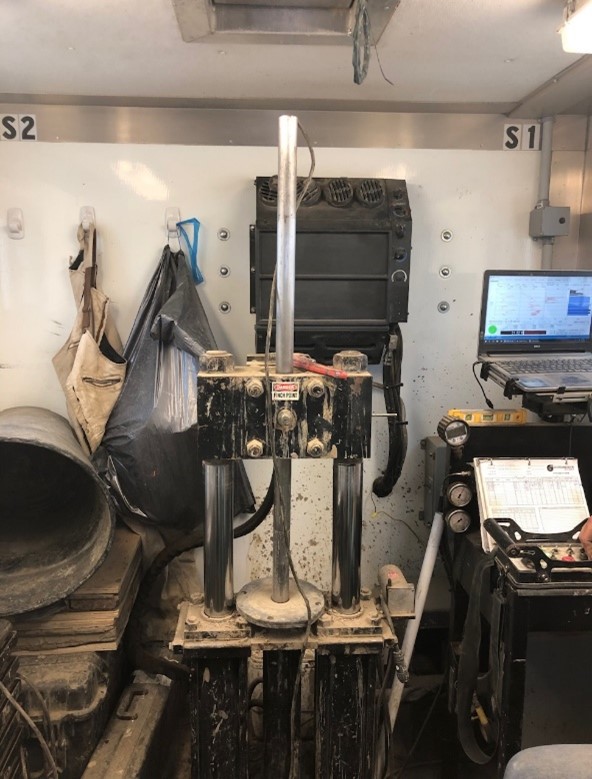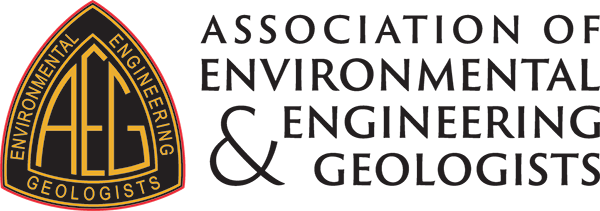It feels like yesterday I got a phone call from the head of the Geotechnology’s geotechnical division concerning my workload in November and December, and if I could go do Cone Penetration Testing (CPT) in Michigan for “a while.” At Geotechnology, there were only two trained operators for the massive, 40,000 lb CPT rig and I am one of them. After being reassured I would be home for the holidays and not miss a thing, I said, “I’m in.”
CPT (cone penetration testing) is a direct push rig that pushes a cone tip vertically into the ground to collect load cell data, think pushing a piece of spaghetti into a cake. Before starting a location, it is important to have the utilities cleared, cone hooked up, rig leveled to ensure a stable push platform, computer software operational with the proper job number/ hole number and the cone cleaned and assembled.

Figure 1: Geotechnology CPT rig tracking to a new location.
As the ~$10,000 cone is pushed into the ground, it collects tip, sleeve, pore pressure and inclination data using load cells within the cone. Additionally, temperature and shear wave data can be collected. This information is processed and displayed on a screen in real-time so we can observe and assess our depth, soil strength, groundwater depth, cone inclination and cone or sleeve refusal. This requires quick thinking and can be stressful because the cone is advanced at approximately 2 cm per second, which seems slow, but is fast enough that during difficult pushing, you have to pay close attention to be able to stop the cone prior to damaging it.
CPT operation is a two-person job because, as the operator is monitoring the push and controller pad, the helper is attaching each additional rod as the push goes deeper and deeper. The helper makes sure that the cord, running through all the rods, does not get pinched or damaged and attaches each rod (1 meter or 3.3 feet) one at a time until the depth is achieved or there is rig/cone refusal. At final depth, the operator switches gears and the cone is then hydraulically pulled back up, cleaned, and placed on the rack until the next hole.

Figure 2: View inside the CPT rig of the head press, rods going down to depth and the computer/controller set up.
This particular CPT job was different from any other I had done. Starting with the location, neither of us had been to Michigan for a job before, let alone somewhere so far north in the winter. Usually, when we are doing CPT for a new building, we will do a few locations across the building footprint, but for this project they weren’t putting in buildings, they were building 75 wind turbines. These wind turbines weren’t just a couple hundred feet apart, they were miles and miles apart so this was a large project that required tracking the CPT rig in and out of each cornfield. Mind you, the CPT rig has a max speed of 2.5mph, so getting from one site to the next was…slow. To save time, instead of driving the rig (slowly) between each site, we decided to load and unload it onto a semi-drop trailer and transport the rig between each site. However, each load and unload cycle still took an hour, resulting in a significant time sink. These wind turbines were over an area of roughly 17 x 10 miles and usually in the center of fields away from trees, sheds and homes.
One unexpected roadblock we encountered on this project was getting the supplies we needed to continue operating. For each hole pushed, we set a temporary well in each location to check groundwater levels. But, to do so, we had to purchase and assemble hundreds of feet of PVC pipe. We went to multiple stores looking for enough PVC pipe for the project, however, many stores were closed for the “holiday” or because of snowy weather. We were a bit confused as to why the stores were closed for the “holiday” when it was still early November. A local informed us it was actually the opening day of Deer Season; everyone in central Michigan considers Deer Season a holiday, and businesses, schools and supply stores shut down! This was extremely helpful information. We made sure to keep our flashers on when driving down the road, safety vests permanently on and the CPT rig lights on at all times. Luckily, we found a Mom and Pop shop that was open, so we bought everything they had!
The other challenge of this project was the most obvious, the “pure” cold weather. Michigan winters chill to the bone no matter how many layers you are wearing. Each morning was the same routine of putting on two pairs of socks, two pairs of pants/long underwear, three long sleeve shirts, ear muffs and a knit cap and then finally my coveralls and jacket. Then, it began to snow, sleet, and the winds picked up, making it even more brutal on your body. Fortunately, the inside of the CPT rig does have heat, and it was usually around 65 degrees Fahrenheit inside. Which, after coming out of freezing temperatures and high winds, felt like a sauna. The whole trip was putting clothes on and off about 10 times a day. The snow and ice made driving a Peterbilt Semi and Ford F-150 on these country roads a challenge at times. When the snow finally melted and the temperatures warmed up to the 40’s, the fields turned to deep, wet mud, which led us to getting the support truck stuck MANY different times. Fortunately, with 40k lbs on steel tracks you have something to pull you out.

Figure 3: This is me taking a second to make a “pure” snow angel.
At the end of the project, we were able to complete all the client requested locations t and, we even went back again at a later time to do additional testing. Pushing in the glacial till of central Michigan was tough and very stiff. But with a lot of experience behind the rig between my partner and I, we overcame the stiff till, the cold weather, random holiday, 10-hour days/nights and long drives to and from St. Louis, Missouri AND St. Louis, Michigan.
I hope you enjoyed my story and have gained better context for all the activities that go into pushing with a CPT rig. If you have other questions or want to know more about CPT, feel free to contact me through AEG or [email protected].

It may not be glamorous, but someday you'll look back proudly on what you accomplished!